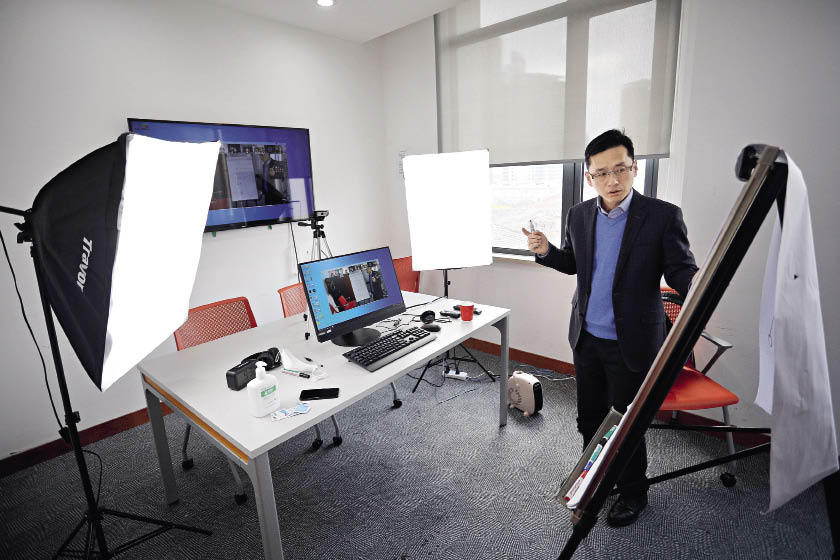
On March 2, 2020, Li Xiaorong, an assistant professor at the Antai College of Economics & Management, Shanghai Jiao Tong University, delivers the first live streaming class of his career. More than 50 students attend it online.
Facing an unprecedented pandemic that has evolved with great unpredictability, schools across the world have shifted to a fully online teaching plan. Online learning in China over the past months has shown encouraging results, which is another reminder of the profound impact technology has on the way we live, learn, and work.
Changing Teacher-Student Relations
As schools move classrooms from the campus to the cyberspace, teachers have to cope with the transition from instructing behind the podium to live streaming from their homes. According to Zhou Jing, director of the Educational Development Center of Hong Kong Polytechnic University, her university provides round the clock technical support for teachers to ensure smooth operation of online classes. At the beginning, the center was overwhelmed by calls from teachers asking for assistance, but the number of calls plummeted after two months, indicating the teachers had grasped enough of the basics of the technology to give online courses.

On March 6, Prof. Cui Jin of Nanjing Agricultural University gives a virtual class on dissecting a Chinese Flowering Crabapple flower, while her students watch from the safety of their homes.
On the part of students, the progress is also evident. A survey by the Tianjin University discovered that 20 percent of the students it reached had a sense of gain through online learning, and think that this new teaching approach is better than conventional teaching methodology (yet to be corroborated by the results of homework and exams). For young students, mostly digital natives who have grown up immersed in the Internet, the shift to online classes has been much easier than it has been for their teachers. Professor François Taddei of the Center for Interdisciplinary Research in France observed that after the campus was closed, some high school students in the country retrofitted gaming platforms into learning ones and invited their teachers to join in. The adaptability, creativity, and initiative of young children cannot be underestimated under the digital environment.
The “fully online curriculum” however exposes some inherent problems in online learning. In some studies students reported lower concentration and efficiency in online courses. This can be attributed to knowledge fragmentation caused by technical diversification, and also highlights the deficiency in the attention to and cultivation of students’ independent study ability in previous education.
In addition to testing concentration and self-control, home studying also heightens the sense of loneliness. As a social animal, humans have the inherent need to associate and interact with others. Contrary to the assumption that the virtual world is ideal for introverts, online learning actually has higher demand for students’ sociability, adaptability, and flexibility. Tomohiro Hoshi, head of Stanford Online High School, has said that sending an email in fact requires more social skills than face-to-face communication. Online education is therefore more challenging for less gregarious children and youth.
Teachers also have their share of problems to overcome during this “fully online curriculum.” Except those who have participated in MOOC, flipped classrooms, and other modes of online education, most teachers were utterly unprepared when moving their classes to the Internet. They had to rush to grasp the technologies needed for the transition, and gave little thought to changes in curriculum and class design. Effective online education is more than just moving instructions from the blackboard to computer screen, and instead requires integration of activities before, during, and after class, as well as tutorship and guidance both online and offline. These issues that go beyond technology and are at the core of education deserve more attention from teachers in their online courses so that continuous improvements will be made.
Technical Challenges
From its very beginning, the “fully online action” has been controversial. Schools, from primary to higher education, have encountered such problems as network overload and connectivity issues, teachers struggling to adapt to the new teaching mode, and some students fumbling to access online courses. Over recent years, both central and local governments have made huge investment into digital infrastructure and resources for schools, which have delivered remarkable results. But still when the nearly 200 million students in China take online courses at the same time, it is inevitable to have the problems of computers crashing and video streams freezing.
The soaring demand for online learning during the epidemic has prompted online platforms to expand and update their systems. Yuketang (Rain Classroom) for instance expanded its capacity 17-fold in two weeks. Zoom, the cloud platform for video and audio conferencing, chatting and webinars, also updated its products and services and saw its market value shoot up.
Despite these updates and improvements, digital technologies and service providers for online teaching have more problems to solve and concerns to address. For instance there are worries about the security of conferences using Zoom. For this reason it is banned for primary school students in New York City. Another example is the e-assessment software. Schools find it difficult to meet their specific needs for holding exams and invigilating them with such software.
Technical issues aside, the human factor also counts: there are blind spots in the application of technologies by teachers, students, and school administrators. Tomohiro Hoshi, head of Stanford Online High School, observed, the reality is not that teachers and students are unable to use technology, but they don’t know how to choose the ones suitable for their circumstances and needs or fully understand the role of technology in amplifying their teaching/learning results. Teachers, students, and school administrators need to explore the impact of technology on teaching and learning over a long period to come after the epidemic ends.
Future Prospects
The “fully online action” has piqued the attention of schools, technology developers, and researchers on the issue of how to support continuous innovation in teaching and learning with new technologies after the epidemic.
Simply moving the content and resources online is only the beginning of technology-induced innovation in education. Without thoughtful design for the new teaching mode, online education will not be much different from conventional practice. If the focus of teachers and students is shifted from transmission of knowledge to innovative learning, students will be led into uncharted territory, make bold explorations, solve practical problems, and build a learning community. This will open the prospect of continuous innovation for both teachers and students aided by new technologies.
With the support of information technology, innovation-driven learning is becoming the future of technology-enhanced learning. As the world evolves so fast, no one can resist the growing, far-reaching impact of information technology on our life and work.
___________
DR. ZHANG XIAOLEI is an associate professor with the School of Education, Tianjin University.